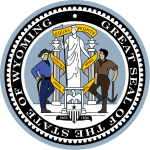| |||||||||||||||||
| Turnout | 28.43% of total population | ||||||||||||||||
|---|---|---|---|---|---|---|---|---|---|---|---|---|---|---|---|---|---|
| |||||||||||||||||
 County results Osborne: 50–60% 70–80% Ivinson: 40–50% No Data/Vote: | |||||||||||||||||
| |||||||||||||||||
| Elections in Wyoming |
|---|
 |
The 1892 Wyoming gubernatorial special election was held on November 6, 1892. Republican Governor Francis E. Warren, who was elected in 1890, resigned several weeks into his term after being elected to the U.S. Senate by the state legislature, elevating Secretary of State Amos W. Barber to the governorship and triggering a special election for the balance of Warren's term.
The Republican Party nominated banker Edward Ivinson for Governor and Democrats nominated former State Representative and former Rawlins Mayor John E. Osborne. In an election that was largely defined by the Johnson County War, in which cattle companies, supported by the state's Republican establishment, attacked alleged rustlers and homesteaders in the Powder River Country. The Republican support for the Wyoming Stock Growers Association severely hurt the party's performance across the state, as Osborne centered his campaign around his opposition to the invasion.[1] Osborne defeated Ivinson by a wide margin, Democrats won a majority in the Wyoming Legislature,[2] and Republican Benjamin Harrison barely won the state in the 1892 presidential election.
- ^ "John E. Osborne: A Sketch of the Next Governor of Wyoming". Salt Lake Herald. Salt Lake City, Utah. August 17, 1890. p. 9. Retrieved June 6, 2021.
- ^ Davis, John W. (November 8, 2014). "The Johnson County War: 1892 Invasion of Northern Wyoming". WyoHistory.org. Wyoming State Historical Society. Retrieved June 6, 2021.

